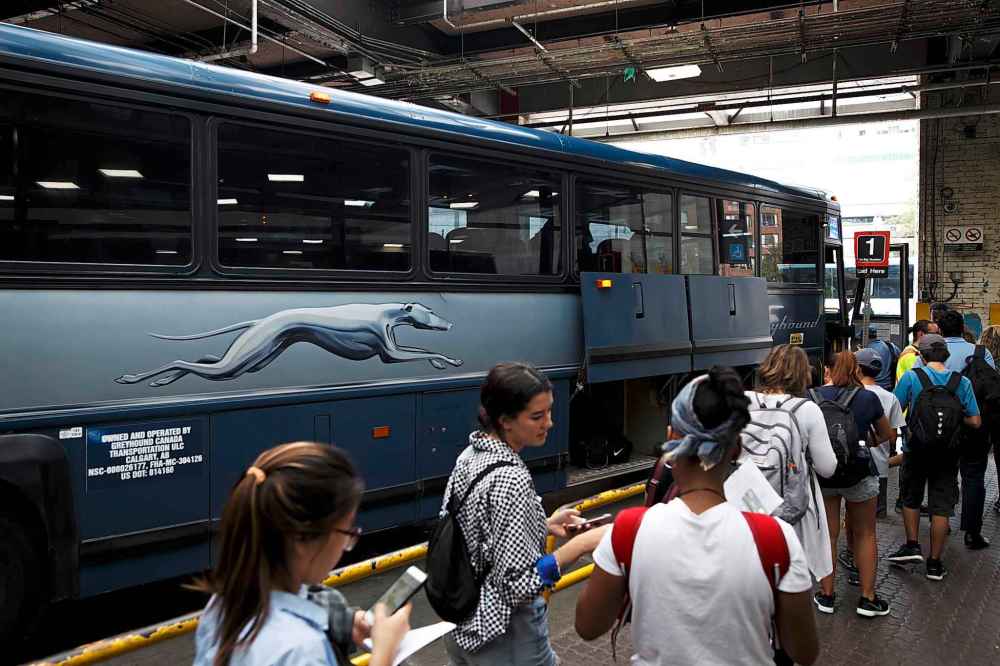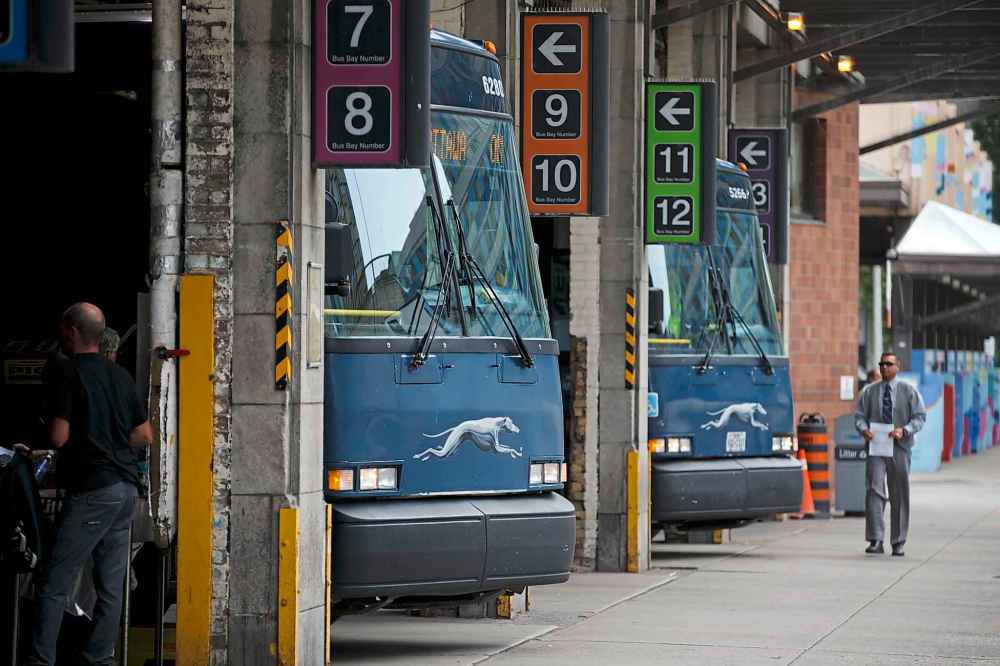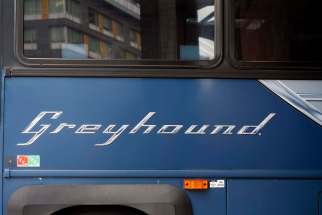Chasing Greyhound Some rural U.S. areas that lost service got back on track with subsidized transport; what direction will Canada take?
Read this article for free:
or
Already have an account? Log in here »
To continue reading, please subscribe:
Monthly Digital Subscription
$0 for the first 4 weeks*
- Enjoy unlimited reading on winnipegfreepress.com
- Read the E-Edition, our digital replica newspaper
- Access News Break, our award-winning app
- Play interactive puzzles
*No charge for 4 weeks then price increases to the regular rate of $19.00 plus GST every four weeks. Offer available to new and qualified returning subscribers only. Cancel any time.
Monthly Digital Subscription
$4.75/week*
- Enjoy unlimited reading on winnipegfreepress.com
- Read the E-Edition, our digital replica newspaper
- Access News Break, our award-winning app
- Play interactive puzzles
*Billed as $19 plus GST every four weeks. Cancel any time.
To continue reading, please subscribe:
Add Free Press access to your Brandon Sun subscription for only an additional
$1 for the first 4 weeks*
*Your next subscription payment will increase by $1.00 and you will be charged $16.99 plus GST for four weeks. After four weeks, your payment will increase to $23.99 plus GST every four weeks.
Read unlimited articles for free today:
or
Already have an account? Log in here »
Hey there, time traveller!
This article was published 27/07/2018 (2694 days ago), so information in it may no longer be current.
OTTAWA – Nevada’s Mineral County went years without bus service. Its rural towns, spread out like most of northern Manitoba, lost Greyhound service in the 1990s, ending a lifeline to the outside world.
“It impacted a lot of people,” recalls Chris Hegg, vice-chairman for the county’s board of commissioners. “We’re kind of on the frontier, as they call it.”
He recalls ads in the local newspaper, where adults working in cities offered to pay local residents with a car to bring their senior parents to medical and veteran appointments in Reno or Las Vegas. “It became a barter service,” he said.
Those ads finally stopped when a subsidized bus service started serving the county seat of Hawthorne in 2014.
As Ottawa and the provinces decide how to fill gaps left by Greyhound Canada’s looming pullout from the Prairies, American transportation experts say those governments need to stop ruling out the idea of bus subsidies.
When Greyhound ended its stops in rural Nevada, most of the 3,200 residents of Hawthorne had cars. But the elderly had trouble making appointments, while police had to drive “transients” out of town, instead of giving them a bus ticket to a larger city.
The town, which sits on the California border, had considered a possible shuttle service, because so many people had to make the two-hour trip to Reno, but it proved too expensive.
“For us, it was pretty serious,” Hegg said, though he suspects even more remote towns were hit harder.
“It became a serious problem,” Hegg said. “We really need the bus.”
When coach service came back in 2014, it was thanks to a program called Formula Grants for Rural Areas, a cost-sharing service in which the U.S. federal government pays roughly four-fifths of a subsidy that makes a bus route profitable, with states choosing the routes and paying the remainder of the subsidy.
These so-called Section 5311 grants serve areas with fewer than 50,000 residents, and have been expanded in the past decades as larger carriers such as Greyhound cut back service.
Joseph Schwieterman, a professor with DePaul University in Chicago, said bus ridership started declining around the 1980s, due to everything from lower gas prices and cheaper airlines to websites that co-ordinate ride-sharing.
The U.S. grants aim to make sure those who can’t access cars or ride-shares can still get around.
“Compared to rail service, it’s a real bargain,” Schwieterman said in a phone interview aboard a coach that connects smaller cities with Chicago’s O’Hare International Airport.
Schwieterman said U.S. bus service has increased in the past decade, largely because of new routes between larger cities, served by smaller vehicles.
“Most of those are a lot more flexible,” he said. “The smaller buses help trim costs.”

Already, firms such as Thompson Bus and Kasper have proposed filling some of Greyhound’s Prairie routes with large vans or smaller coaches. Still, Schwieterman said those firms likely won’t be able to serve all of Greyhound’s destinations, and it could be months before they turn a profit.
“Without subsidies, it will be a piecemeal solution, at best," he said.
Fred Fravel, a transportation planner with the KFH Group in Bethesda, Md., said governments in the U.S. and Canada had tried to avoid subsidies by instead implementing regulations that only allowed companies to serve certain areas if they made stops at less-profitable destinations.
Manitoba held such a system until 2012, and Greyhound immediately cut service once it was curtailed.
“It looks to me like many of the Canadian provincial governments were stuck very hard on the cross-subsidy mechanism, and that just isn’t feasible in today’s world,” Fravel said.
“Greyhound’s been making noises for long enough about their issues, and people should should have been looking at it before this.”
He said deregulation further undercut coach carriers’ profits, with routes between major cities such New York and Washington, D.C., now served by multiple companies offering competing rates.
“Greyhound’s been making noises for long enough about their issues, and people should should have been looking at it before this”
– Fred Fravel, a transportation planner with the KFH Group in Bethesda, Md.
“If you have a small market and you split it up among a bunch of carriers, none of them are going to produce a lot of revenue that they can use to support unprofitable services elsewhere,” he said, adding private companies’ shareholders wouldn’t entertain the idea anyway.
Canadian companies face much tighter regulations, but upstarts such as Megabus serve Toronto, Montreal and New York, using curbside pick-ups instead of bus stations and undercutting Greyhound’s most profitable routes.
“If we think they’re a public good, those services, then we have to use public money to support them. And the best way to do that, is to do some sort of a contracted regime, where you have bus companies competing to operate,” Favel said, adding it ultimately saves governments when a single line serves medical patients, students and airport travellers, even when each pay different fares.
Jeremy Mattson, a transportation researcher with North Dakota State University, said Canada might end up with a variety of firms offering travel using a range of vehicle sizes. He said the key is having some level of government making sure they can get people to major hubs.
“You might have a variety of different types of services, but they need to be connected and co-ordinated,” said Mattson, who has spent a decade with the school’s Upper Great Plains Transportation Institute.
While the bulk of Canadian transportation research focuses on air and rail travel, there is scant data Canadian data collected on inter-city bus service.

Meanwhile, Greyhound refused to give the Manitoba government data on the ridership and profitability of its routes after it threatened to pull out of the province in 2009, instead leaking select information to media.
Mattson said he encounters the same problem in the U.S., with companies competing with each other reluctant to share their records with academics. He instead has surveyed people across North Dakota on how they choose from various modes of transport.
Unsurprisingly, he found bus service is appealing to people with disabilities and some of the elderly who don’t feel comfortable driving long distances. But he also found young people who don’t have access to a car also rely heavily on bus services in remote communities.
Those two trends may echo the demographics of rural Manitoba, with aging northern towns and a much younger population on First Nations reserves, though without high enough incomes to own a car.
Mattson’s research found passengers prefer clean, comfortable and reliable bus service. But they also are more likely to choose a transportation option when they feel people who take the mode of transportation “are like me,” meaning they have the same demographics.
“If we think they’re a public good, those services, then we have to use public money to support them”
– Fred Fravel
Schwieterman said Greyhound has an image issue in the United States, because many of its passengers can’t afford a vehicle or low-cost flights, or they’re too elderly to drive, meaning people start associating coaches with older or poor people.
"Interstate buses face a stigma, and Greyhound often faces the worst of that,” he said. “When you travel for business, you typically don’t go with Greyhound, because certain people perceive that a certain way.”
A decade ago, Greyhound launched a service called BoltBus, serving larger cities with brightly coloured coaches that can only be booked on a separate website. The service is intentionally marketed to younger people, and its Seattle-Vancouver line will be the only Greyhound service in Canada west of the Great Lakes, as of Oct. 31.
In the wake of Greyhound announcing its prairie pullout this month, Canadian governments have pushed back on the idea of any subsidy.
Manitoba Infrastructure Minister Ron Schuler has noted the province had already offered Greyhound subsidies, which didn’t stop it from announcing a service reduction.
Schuler has said all affected provinces prefer asking the company for two more months of service, to allow more time for smaller companies to fill the gaps Greyhound will leave. Federal officials have told media Ottawa’s considering loan guarantees for such companies.

On Monday, senior bureaucrats from each province and the federal government gathered in Toronto for a pre-scheduled meeting. A Manitoba government source said none had brought up a subsidy for operators, or even loan guarantees.
But polling released Friday shows most Canadians prefer some sort of subsidy. Angus Reid found 60 per cent of respondents support federal subsidies for rural bus services, and 64 per cent support a provincial subsidy.
A smaller majority, 56 per cent, said subsidies are needed because private businesses can’t fill gaps needed to sustain communities.
In a Friday interview, Greyhound Canada senior executive Stuart Kendrick said his company had pushed provinces for years to emulate the U.S. subsidy system. He said it provides enough regulations to compel decent service for remote and low-income people, and would likely help Greyhound’s competitors.
“There hasn’t been much co-ordination done on the national level," Kendrick said. “Unfortunately, I don’t believe that the private sector on its own will come in and fill the void; they’ll probably be looking for some assistance.”
Mattson fears Canadians risk seeing smaller towns die if there’s no government backing of the private market, even if it’s not a direct subsidy.
“I think it’s really valuable to provide service to those rural, remote areas,” he said. “So if private operators aren’t willing to provide those services, you have to invest in the public transit.”
dylan.robertson@freepress.mb.ca
History
Updated on Friday, July 27, 2018 7:04 PM CDT: Adds map

















